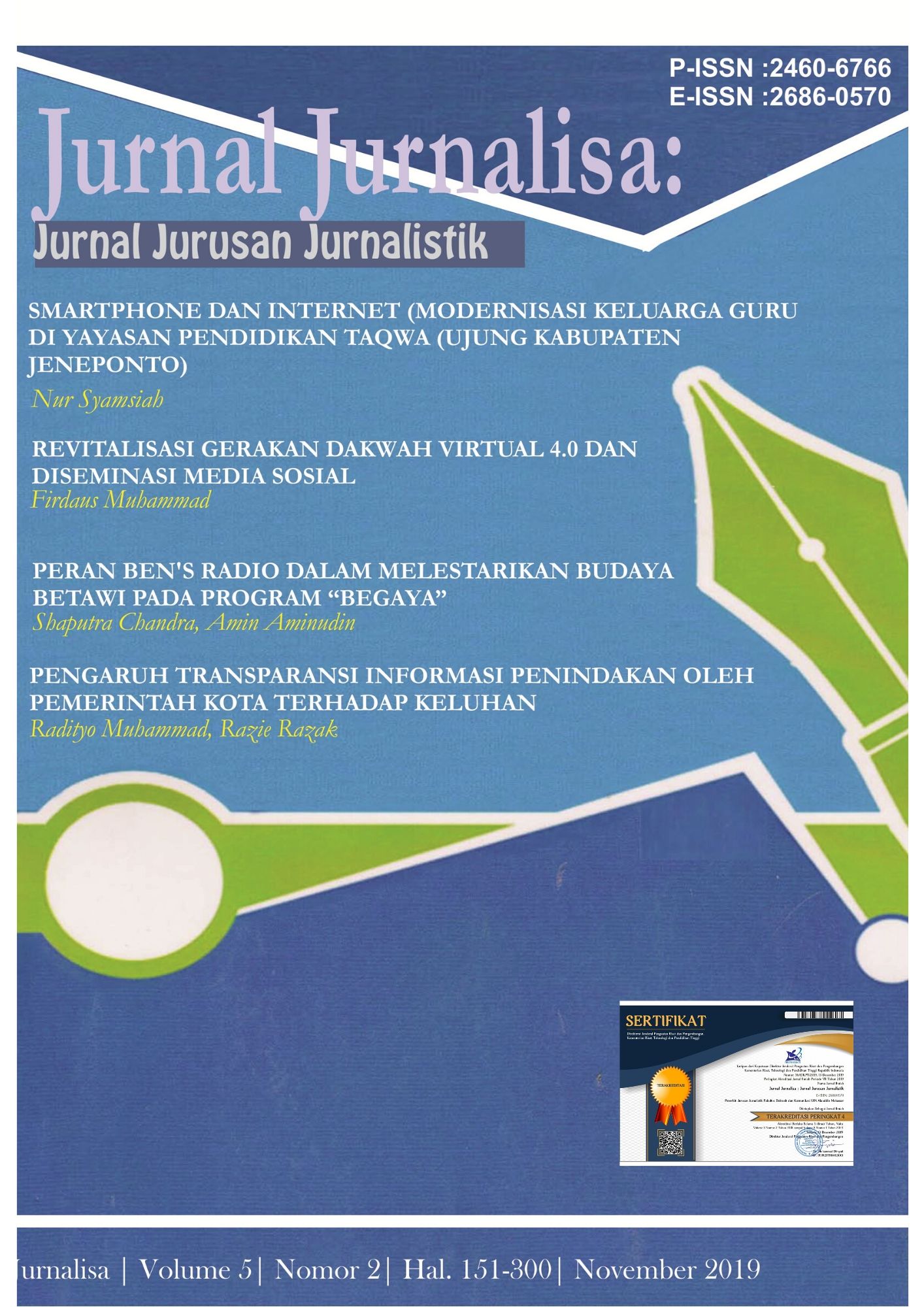TRADISI JAMAAH HAJI ORANG BUGIS SEPULANG DARI TANAH SUCI MEKAH (PERSPEKTIF KOMPASTV MAKASSAR)
Abstract
Once a year, Muslims of every ethnic group, color, social status, and culture gather together in Mecca and stand before the Kaaba praising Allah together. a religious tradition that brings millions of devout Muslims to the holy city of Mecca, Saudi Arabia.Muslims, especially Bugis People, At the end of the hajj, pilgrims return home and are often given the honorific “hajji,” meaning one who has performed the hajj.The research object is the local daily KOMPASTV in Makassar, KOMPAS TV in Makassar as a sample. Currently, technology has gained increasing attention as a major means to provide servicesThe research was aimed to analyze the tradition of hajj Bugis people pilgrimage from Mecca Bugis Family members often prepare a celebration to welcome pilgrims home and congratulate them on completing the journey. It is recommended to be humble in such gatherings and to ask the ones returning from Hajj to pray for your forgiveness, as they are in a strong position to do so. Once a year, Muslims of every ethnic group, colour, social status, and culture gather together in Mecca and stand before the Kaaba praising Allah together. a religious tradition that brings millions of devout Muslims to the holy city of Mecca, Saudi Arabia.Muslims, especially Bugis People, At the end of the hajj, pilgrims return home and are often given the honorific “hajji,” meaning one who has performed the hajj.The reaserach object is the local daily KOMPASTV in Makassar, KOMPASTV in Makassar as a sample. Currently, technology has gained increasing attention as a major means to provide servicesResearch was aimed to analyze tradition of hajj Bugis people pilgrimage from MeccaBugis Family members often prepare a celebration to welcome pilgrims home and congratulate them on completing the journey. It is recommended to be humble in such gatherings and to ask the ones returning from Hajj to pray for your forgiveness, as they are in a strong position to do so.Downloads
References
Abu Hamid, dkk., Siri’ dan Pesse. Cet. I; (Makassar: Pustaka Refleksi, 2003).
Ahmadin, Kapitalisme Bugis: Aspek Sosio-Kultural dalam Etika Bisnis Orang Bugis. Cet. I; (Makassar: Refleksi, 2008).
Al-‘Aqil, Syaikh Thalal & Khalid Al-Jabir. Dalilul Hajji Shihhatuka fii Al-Hajji yang dialihbahasakan oleh Syarif Baraja dengan judul “Benar dan Sehat Berhaji”. Cet. III; (Solo: Aqwam, 1435 H).
Al-Kandahlawi Rah.A, Maulana Muhammad Zakariyya. Fadhâil Al-Hajj yang telah dialihbahasakan dengan judul “Fadhilah Haji”. Cet. I; (Bandung: Pustaka Ramadan, t. Thn.).
As-Suwaidan, Thariq. Asrarul Hajji Wal ‘Umrah yang dialihbahasakan oleh Umar Mujtahid dengan judul “Keajaiban Haji dan Umrah”, Cet. II; (Solo: Zam-zam, 2016).
Darmapoetra, Juma. Suku Bugis; Pewaris Keberanian Leluhur. Cet. II; (Makassar: Arus Timur, 2014).
Departemen Pendidikan Nasional, Kamus Besar Bahasa Indonesia Pusat Bahasa. Edisi Keempat. (Jakarta: PT Gramedia Pustaka Utama, 2008).
Eriyanto, Analisis Wacana: Pengantar Analisis Teks Media. Cet. V; (Yogyakarta: PT LkiS Pelangi Aksana, 2006).
Hamad, Ibnu. Konstruksi Realitas Politik Dalam Media Massa: Sebuah Studi Critical discourse analysis terhadap berita-berita politik. Cet I; (Jakarta: Yayasan Obor Indonesia, 2004).
Hanbal, Imam Ahmad bin. al-Musnad, xv/91. Imam al-Thabrani, al-Mu’jam al-Kabir, ix/384.
Hasrullah, Megawati Dalam Tangkapan Pers. Cet. I; (Yogyakarta: LkiS, 2001).
Kasman, Suf. Jurnalisme Universal; Menelusuri Prinsip-Prinsip Dakwah bi Al-Qalam Dalam Al-Qur’an. Cet. I. (Jakarta: Teraju, 2004).
_______. Pers dan Pencitraan Umat Islam di Indonesia; Analisis Isi Pemberitaan Kompas dan Republika. Cet. I; (Jakarta: Badan Litbang dan Diklat Kementerian Agama RI, 2010).
Muhammadiyah, Hilmy. Perempuan Bugis Naik haji; Sebuah Tinjauan Antropologis, Cet. I; (Depok: Elsas, 2009).
Najati, Muhammad ‘Utsman. Al-Qur’an wa ‘Ilmu Al-Nafs. Cet. III; (t. tp.: Dar Asy Syuruq, 1987 M/1407 H).
Nidjam, Achmad & Alatief Hanan. Manajemen Haji; Studi Kasus dan Telaah Implementasi Knowledge Workers. Cet. I.; (Jakarta: Zikrul Hakim, 1987).
Rochimi, M. Abdurachman. Segala Hal Tentang Haji & Umrah. Cet. XII; (Jakarta: Erlangga, t. th.).
Rofiq, Ahmad. Fiqh Aktual: Sebuah Ikhtiar Menjawab Berbagai Persoalan Umat. Cet. I; (Semarang: Putra Mediatama Press, 2004).
Sabiq, Al-Sayyid. Fiqh Al-Sunnah. Jilid I cet IV; (Beirut: Dar Al-Fikr, t. Th.).
Sati, D.A. Pakih. Orang Miskin Pun Bisa Naik Haji. Cet. I; (Surakarta: Ahad Books, 2013).
Shihab, Muhammad Quraish. Membumikan" Al-Quran; Fungsi dan Peran Wahyu Dalam Kehidupan Masyarakat. Cet. XX; (Bandung: Mizan, 1999).
Sholikhin, Muhammad. Keajaiban Haji dan Umrah; Mengungkap Kedahsyatan Pesona Kabah dan Tanah Suci. Cet I. (Jakarta: Erlangga, 2013).
Sudibyo, Agus. Politik Media dan Pertarungan Wacana. Cet. II; (Yogyakarta: PT LkiS Pelangi Aksana, 2006).
Supiana, Materi Pendidikan Agama Islam. Cet. I; (Bandung: PT Remaja Rosdakarya, 2001).
Syariati, Ali. Hajj yang dialihbahasakan oleh Burhan Wirasubrata dengan judul “Makna Haji”. Cet. XII; (Jakarta: Zahra, 2009).
Tim Ilmiah, Refleksikan Hajimu; Membumikan Nilai-nilai Pendidikan dalam Ibadah Haji. Cet I; (Riyad: Maktab Al-Nusaim Da’wah wa Irsyad, 1436 H).
Yaqub, Ali Mustafa. Mewaspadai Provokator Haji. Cet. I; (Jakarta: PT Pustaka Firdaus, 2009).
WEB
http://kantorurusanhaji.com/pengertian-ibadah-haji/
https://www.youtube.com/watch?v=iUVGeBamNUY
https://nasional.kompas.com/read/2008/06/10/20422993/merantau.bagi.orang.bugis.untuk.kebebasan
https://www.dream.co.id/your-story/ini-peringatan-rasulullah-tentang-motif-berhaji-1609098.html
http://pwi-sulsel.blogspot.com/2011/01/sulsel-miliki-76-media-cetak-28-radio.html
https://pemudabulobulo.blogspot.com/2018/09/awal-mula-suku-bugis.html
https://www.tribunnews.com/nasional/2018/10/22/ini-dia-5-tradisi-haji-di-beberapa-daerah-indonesia.
Once an article was published in the journal, the author(s) are:
granted to the journal right licensed under Creative Commons License Attribution that allows others to share the work with an acknowledgment of the work's authorship. permitted to publish their work online in third parties as it can lead to wider dissemination of the work. continue to be the copyright owner and allow the journal to publish the article with the CC BY license receiving a DOI (Digital Object Identifier) of the work.

